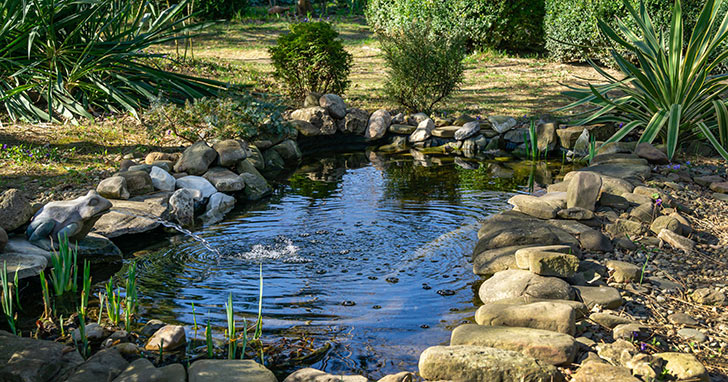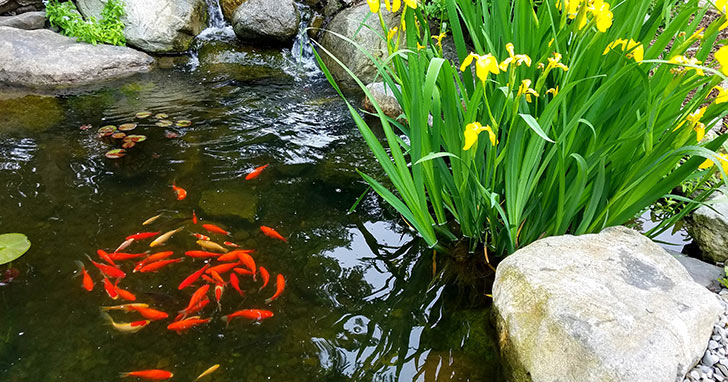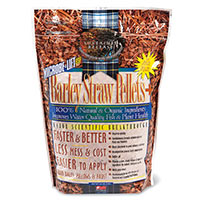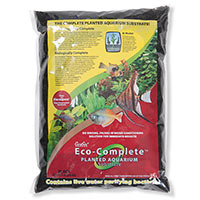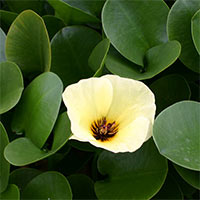Thinking of Creating a Pond? – You Can Start Small
An Introduction to Ponds Benefits to creating smaller pond or container features are that they are easy to redesign or move. They are less expensive to create and maintain than a larger in-ground pond and in most cases set up is a weekend project. Location - Full Sun or Partial Shade Deciding on a location is one of the first steps to creating a container pond. For smaller containers, incorporating live fish may not be an option, as koi require a minimum pond size of 1000 gallons, and even goldfish require a minimum of containers of at least 30 gallons. But you will still be able to create a plants-only container that will add beauty to your home. When selecting plants, there are two criteria to consider: the U.S. planting zone you are located in, and whether you want to place your container in full sun or partial sun. Even when located in partial sun, your container should receive at least six hours per day to ensure plant and water health. Placing your container in an area that receives a lot of morning light is preferred to an area that receives midday sun. Other considerations for container placement:
Select Your Container If you are creating a water container with only ornamental items added for aesthetics and perhaps a pump for filtration and water movement, any non-porous container will do. These could include a wooden or metal bucket, large bowl, livestock watering trough, or large plant pots. However, if you are incorporating plants, you must create an environment that supports that life, and you should avoid containers that may have held wine or whiskey as the wood can hold bacteria and contaminates. If you have your heart set on that type of container, use a liner. If housing plants, plastic containers are not ideal options, as ones that contain PFAS (polyfluorinated compounds) or BPAs (Bisphenol A), can leech harmful chemicals into your container. It is better to use other materials that will not deteriorate after time. For floating plants, depth is not as much as an issue, but if you are planting bog plants that sit on the bottom of your container, select a container deep enough to accommodate the plants you select. Be sure to clean your container before use. Use a waterproof sealant to fix holes and add a liner if needed for any of the reasons mentioned above. Water When setting up your container pond and throughout the season, you will need to test your water. Whether you are using rainwater or dechlorinated tap water, you should test it and treat as needed to remove any harmful compounds such as ammonia and chlorine that can be harmful and even deadly to your plants and for any wildlife visiting your pond. There may be other components that your plants require such as desired pH level, water hardness, etc. To enable small birds to drink from the container, either keep the water level close to the rim or provide a branch on which they can land and perch. Creating floating plants or islands in the water with part of them protruding above the water line would enable smaller insects and butterflies to land in your pond to cool off or take a drink. Soil/Substrate When setting up your planted pond, you may want to place larger bricks or rocks to weigh down the container. You can also create platforms or levels where you can anchor your plants. For anchoring plants, you can place one to two inches of soil in your container, but garden potting soil is not a good option because much of it will float. But there are many other options from which to choose. Clay soil is a good option for anchoring plants as it contains nutrients, just be sure not to place too much so it does not damage or overpower the roots, as it is a heavy medium. Aquatic soil, or one made up of kiln-fired particles, is a good choice because it holds nutrients. Gravel can be used for short plants but offers no nutritional value for your container.
Plant Selection Since most small container ponds are not large enough to hold enough water to maintain fish, many hobbyists create interest by including plants that float on the surface of the water. In deeper containers, you can include bog plants that are anchored to the bottom. There are a number of floating grasses and plants from which to choose, and many people like to incorporate flowers to bring color to their water feature. Water Lilies and Lotus plants are popular choices. The amount of sun your container gets each day and which U.S. planting zone you are located in are criteria you can use to select plants that will thrive. For best visual interest, select a balanced selection of plants and do not overplant. Allow space between plants so you can admire each one separately. Algae and Mosquito Control Pond aeration of smaller containers is not necessary unless you would like some type of water movement that a small bubbler or fountain feature offers in order to keep algae and mosquitos at bay. Floating plants on the water’s surface will keep the water cooler and starve algae for sunlight. There are also UV sterilizers that kill floating green water algae. You can also use a natural approach such as including barley straw or barley straw pellets on the bottom of your container, which inhibits algae growth as it decomposes. Water and Pot Maintenance Now is the time to sit back and enjoy your water feature. During the season, maintenance consists of removing debris that accumulates in your container, trimming plants as necessary and replacing water used by wildlife or lost due to evaporation.
Recommended Products
|
|||||
|
|



